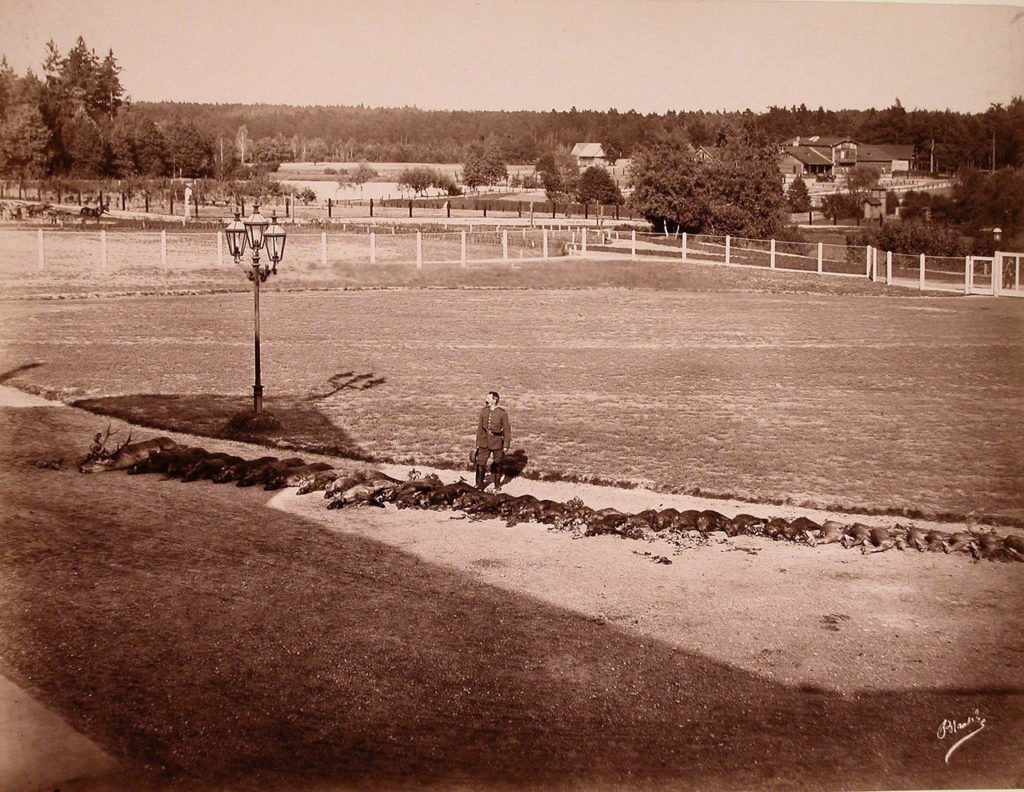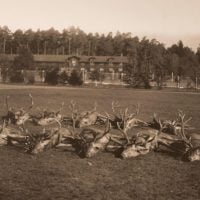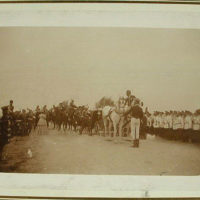
Related

A huntsman in a harnessed cart with a reindeer killed on the hunt. Members of the imperial family in the Spala. 1890

A huntsman in a harnessed cart with a reindeer killed on the hunt. Members of the imperial family in the Spala. 1890

A group of huntsmen near deer, killed during the hunt. 1894.

The huntsman is lucky in the cart of deer killed during the hunt. 1892

Deer killed during the hunt. 1894

The Tsar's Hunt 1894, Russian Empire, 19th century

A group of huntsmen on one of the bays of the Belovezhskaya Pushcha

With killed Zubr. The Tsar's Hunt 1894

A member of the Spala royal hunt shows the horns of a dead deer.
A huntsman with a reindeer killed on the hunt. Stay members of the imperial family in the Spa. 1890
Summary
Huntsman with deer killed on the hunt. Stay members of the imperial family in the Spa.
The royal estate Slela, the Lovel Principality in Poland, in 1890.
Егерь с убитыми на охоте оленями. Пребывание членов императорской фамилии в Спале.
Царское имение Спала, Ловическое княжество в Польше, 1890 год.
Alexander III was the second son of Alexander II and of Maria Aleksandrovna (Marie of Hesse-Darmstadt). During the first 20 years of his life, Alexander had no prospect of succeeding to the throne. His training and acquaintance was with French, English, and German, and military drill. When he became heir apparent on the death of his elder brother Nikolay in 1865, he began to study the principles of law and administration under the jurist and conservative philosopher K.P. Pobedonostsev. The tsesarevich Nikolay, on his deathbed, had expressed a wish that his fiancée, Princess Dagmar of Denmark, known as Maria Fyodorovna, should marry his successor. The marriage proved a happiest one. On March 13 (March 1, O.S.), 1881, Alexander II was assassinated, and the following day autocratic power passed to his son. Alexander III political ideal was a nation with one language, one religion, and one form of administration, he sought to strengthen and centralize the imperial administration.
Belovezhskaya Pushcha became the property of the royal family in 1888 in exchange for lands in the Orel and Simbirsk provinces. After the construction of the Belovezhsky Imperial Palace was completed, Alexander III, Nicholas II, Grand Dukes often hunted in the Pushcha. In the town of Bialowieza (now Poland) a palace was built - a luxurious hunting residence with a beautiful park of 50 hectares. Only the entrance gates and several surrounding structures survived. There are numerous photographs of Nicholas II during the hunt in these places. Grand Duchess Tatiana Nikolaevna reported with great enthusiasm on September 21, 1912 from Spala to her aunt - Grand Duchess Xenia Alexandrovna. "My dear Aunt Xenia ...": "It was terribly fun in Bialowieza. We went with Papa to hunt Olga and I. Marie was with Anastasia only twice." I stood two times with Papa on the number, since Prince Golitsyn, Prince Beloselsky and once at Drentina. "It was terribly good."
В 1886 году Российский Император Александр III, будучи на маневрах в Высоко-Литовске, изъявил желание поохотиться в Беловежской пуще. A в 1888 году царь издал указ о передаче Беловежской пущи в собственность императорской семьи в обмен на царские земли в Орловской и Симбирской губерниях. Тогда же Александр III принял решение построить охотничий дворец в центре Беловежской пущи — в деревне Беловеж. Строительство дворца по проекту графа Николая де Рошфорта было начато в 1889 году и шло на протяжении шести лет. В августе 1894 года еще не до конца отделанный дворец посетил Александр III. Однако дворец его не впечатлил. После смерти Александра III дворец переходит его сыну и наследнику Николаю II, который часто приезжал в Беловеж с гостями на охоту или с женой и детьми на отдых. Окончание строительства и внутренняя отделкой дворца проходили под руководством архитектора И.В. Жолтковского. Кирпичное двухэтажное здание дворца было построено в стиле средневекового замка с высокими башнями, круглыми остроконечными крышами. В отделке и меблировке дворца использовались все породы деревьев, которые растут в Беловежской пуще: сосна, ель, дуб, ильм (берест), граб, береза, клен, ольха, осина. Роспись на потолках и фризы передней, вестибюля, столовой, бильярдной, кофейной, великокняжеских и свитских помещений принадлежали кисти художника Ясинского. Во всех жилых комнатах находились иконы. Большинство комнат имели свое название: великокняжеские покои именовались «Со львами», «Берестовая», «Сосновая»; свитские комнаты - «Ночь», «Заря», «Красная», «Зеленая», а комнаты фрейлин - «Маки», «Беседка». В 1895 году вокруг дворца закладывается богатый парк в английском стиле. Одновременно, по проекту Валерия Кроненберга, создаются два пруда путем запруды Наревки в южной части парка. Забор парка напоминал ограду Летнего сада в Санкт-Петербурге. Многие деревья вокруг дворца высаживались по особой технологии: зимой деревья с замерзшей землей выкапывались и переносились в заранее подготовленные ямы. В 1897 году был освящен храм святителя Николая Чудотворца. Он находился неподалеку от дворца и был предназначен для царя и его свиты. Этот храм сохранился. В 1958 году разрушенный во время Второй Мировой войны дворец был взорван. На месте руин был возведен новый комплекс зданий, вклачающий гостиницу, ресторан и музей. По материалам статьи Николая Черкас, научного сотрудника национального парка «Беловежская пуща». http://www.ohotniki.ru/editions/huntingfishing/article/2009/05/28/287623-iz-istorii-tsarskogo-ohotnichego-dvortsa-v-belovezhe.html In 1886, Russian Emperor Alexander III, being on maneuvers in High-Litovsk, expressed a desire to hunt in Belovezhskaya Pushcha. Later, in 1888, he issued a decree and transferred Belovezhskaya Pushcha estate to the imperial family in exchange for the lands in the Orel and Simbirsk provinces and ordered to build a hunting palace in the village of Belovezh. The construction of the palace, designed by Count Nikolai de Rochefort, was started in 1889 and took six years. In August 1894, Alexander III, visited the unfinished palace that did not impress him. After Alexander's death, the palace was very much liked by his heir Nicholas II, who often came to Belovezh to hunt and for a family vacation. The palace completion and interior decoration were done under the guidance of architect I.V. Zholtkovsky. The two-storeyed brick building of the palace was stylized after a medieval castle with high towers. Trees that local for Belovezhskaya Pushcha were used in decorating and furnishing the palace: pine, spruce, oak, elm (birch bark), hornbeam, birch, maple, alder, aspen. Ceiling paintings, as well as friezes, were made by artist Yasinsky. In 1895, the English-style park and two ponds were added. The fence of the park resembled the fence of the Summer Garden in St. Petersburg. Trees around the palace were planted using a new technology: the trees with frozen ground were dug out and transferred into new pits in the winter. In 1897 the church of St. Nicholas the Wonderworker was consecrated near the palace. Unlike the place, it has survived. In 1958, badly damaged during the Second World War, the palace was blown up and demolished. On the site, a new complex of buildings was built: a hotel, a restaurant, and a museum. Based on the article by Nikolai Cherkas, a scientific employee of the National Park "Belovezhskaya Pushcha" http://www.ohotniki.ru/editions/huntingfishing/article/2009/05/28/287623-iz-istorii-tsarskogo-ohotnichego-dvortsa-v-belovezhe.html
- Alexander III - Александр Третий
- 49 Спала Image: PICRYL - Collections - GetArchive
- 49 Спала Images: PICRYL - Public Domain Media Search Engine ...
- 49 Спала Images: PICRYL - Public Domain Media Search Engine ...
- 50 Дворец в беловеже Images: PICRYL - Public Domain Media ...
- 49 Спала Images - Romanov Empire - Империя Романовых
- 48 Spala Images - Romanov Empire - Империя Романовых
- Дворец в беловеже - Romanov Empire - Империя Романовых
- 48 Spala, Russia Images - Romanov Empire - Империя Романовых
- Imperial Palace in Bialowieza - Императорский дворец в Беловеже
